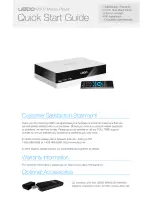
28
Argus Encoder Family Version 2.6 API Developer’s Guide
Events
can choose whether or not to register and respond to Filter Manager events. Most
likely, you’ll want to register to receive them. Only through events can Filter
Manager let your application know that it has finished an encode — and whether
or not the encode finished successfully.
From the Filter Manager outgoing interface, a
message
and a
code
are passed
each time an event is fired. The
message
is used to display a detailed message
string describing the event. In the case of an Error event, the
code
specifies the
error that occurred. For events other than error events, the code parameter may
be 0, indicating a successful outcome. Codes with negative values are generally
error codes. All others are status codes.
The Filter Manager interface supports the following events:
HRESULT ErrorEvent(long code, BSTR message)
is issued when a processing
error has occurred.
HRESULT LogEvent(long code, BSTR message)
is issued to inform the client of
the status of the encoding process or of a recently-called method. It is informational
only. If the code value is negative, the log event can be considered a warning.
Spectrum users should note that a log event whose code value is 99 has a special
meaning and requires special processing. Filter Manager issues log events tagged
with a 99 to indicate the progress of secondary stream indexing after a Real or
WMF encode has finished. These log messages should be filtered out to prevent
the log file from growing too large.
HRESULT FinishedEvent(long code, BSTR message)
is issued to inform the
client that the encode is completely finished.
HRESULT PauseEvent(long code, BSTR message)
is issued to inform the cli-
ent that a scheduled pause has taken place. If the value of
code
is 1, the encoder is
waiting for the client application to issue a call to
TapeChanged()
(see descrip-
tion below) before resuming. This allows the calling application to give the
encoder operator a variable amount of time to change a tape or to otherwise reset
the tape deck. If the value of
code
is 0, the encode resumes automatically.
For an explanation of how to register events in your C++ or Visual Basic appli-
cation, see the respective sections of this manual that describe C++ and Visual
Basic client applications. For a more detailed explanation of COM events, refer
to the recommended COM reading references listed in Chapter 1, particularly
the book
ATL Internals
.
















































